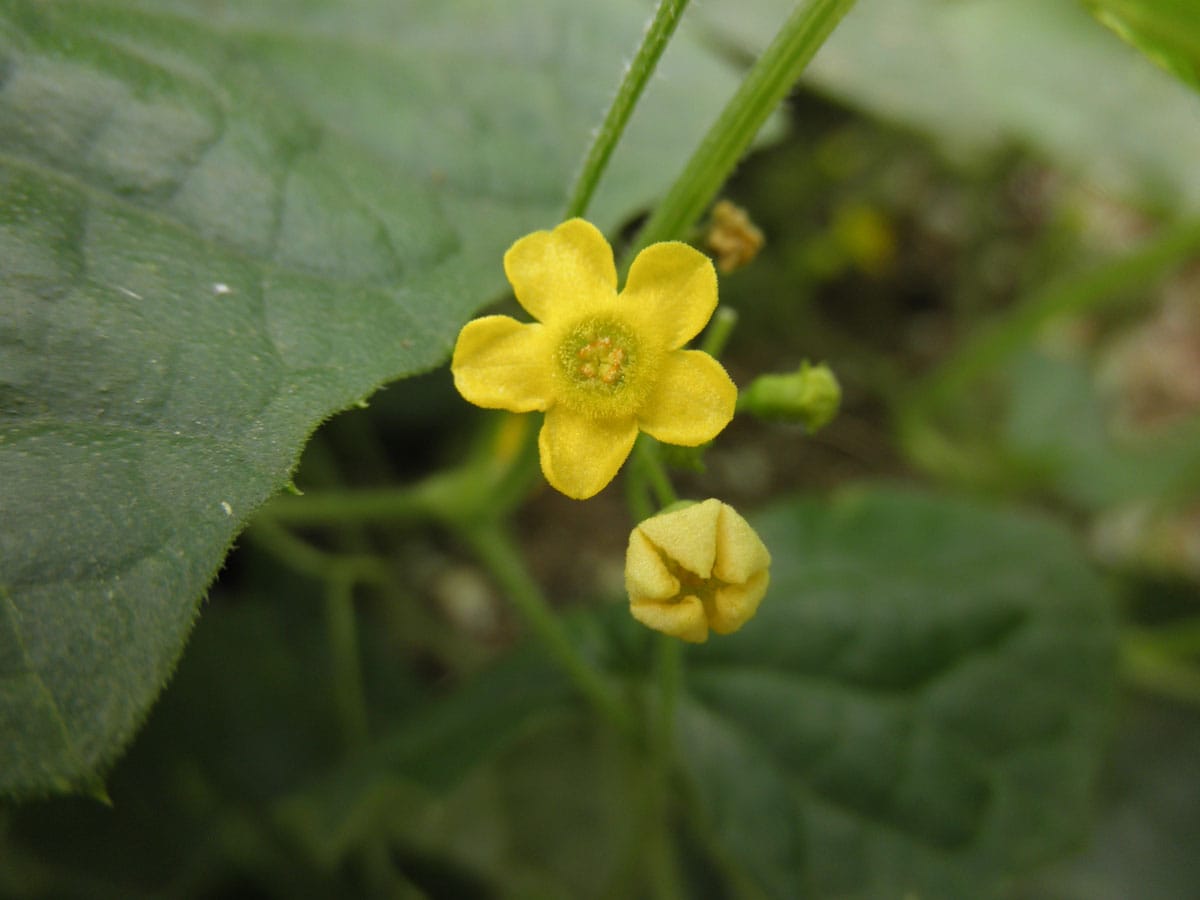Cucamelons (Melothria scabra): The grape-sized fruit with a surprising tang, easy to grow in your own garden. This comprehensive guide will equip you with everything you need to know about cultivating and savoring these quirky little treats, from seed to plate. Whether you’re a seasoned gardener or just starting out, get ready to dive into the wonderful world of cucamelons!
Discovering the Cucamelon
What is Melothria scabra? This charming, bite-sized fruit, resembling a miniature watermelon, goes by many names: cucamelon, Mexican sour gherkin, mouse melon, and pepquinos, to name a few. Native to Mexico and Central America, this vigorous vine belongs to the Cucurbitaceae family, alongside cucumbers and pumpkins. Its small, yellow flowers give way to abundant, grape-sized fruits with a refreshing, tangy flavor – a delightful blend of cucumber and lime. Intrigued? Let’s delve deeper.
Cucamelon Plant Profile: A Closer Look
- Scientific Name: Melothria scabra
- Common Names: Cucamelon, Mexican miniature watermelon, Mexican sour cucumber, Mexican sour gherkin, mouse melon, pepquinos
- Family: Cucurbitaceae (Cucumber family)
- Type: Herbaceous perennial vine (often grown as an annual in cooler climates due to frost sensitivity)
- Size: 2.5-3 meters (8.2-9.8 feet) tall
- Growth Habit: Climbing (requires a trellis or other support)
- Leaves: 3-7 cm long and wide, with three or five lobes, slightly rough texture
- Flowers: Small, yellow, approximately 4mm
- Fruit: Grape-sized, resembling miniature watermelons, with a tart, citrusy flavor
- Native Range: Mexico to Venezuela (specifically Colombia, El Salvador, Guatemala, Honduras, Mexico, Nicaragua, Panama, and Venezuela)
- Habitat: Forests and thickets
- Growth Speed: Fast-growing, germination in ~10 days, maturity in 60-75 days
Growing Cucamelons: A Step-by-Step Guide
Cultivating cucamelons is a rewarding experience, even for beginners. This step-by-step guide will navigate you through the process, from sowing seeds to harvesting your first crop. Can you grow cucamelons in the UK? Absolutely! But there are some climate-specific considerations we’ll address later.
Starting Seeds
Begin your cucamelon journey by sowing seeds indoors 4-6 weeks before the last expected frost. Sow seeds about half an inch deep in seed trays filled with moist seed-starting mix. A warm, sunny spot indoors is ideal for germination, which typically takes 7-10 days. Alternatively, direct sow outdoors after the last frost when soil temperatures reach a consistent 60°F.
Transplanting Seedlings
Once seedlings develop a couple of true leaves (distinguishable from the initial seed leaves), and the danger of frost has passed, transplant them outdoors. Choose a sunny location with well-drained soil. Since cucamelons are climbers, providing support is crucial. A trellis, fence, or sturdy tomato cage will do nicely. Space plants 12-18 inches apart to allow for ample growth.
Ongoing Care
Cucamelons are relatively low-maintenance but thrive with regular watering, especially during dry spells. Feeding them with a balanced fertilizer every few weeks encourages healthy growth. Pinching back the tips of the vines promotes bushier growth and can increase yield.
Pest and Disease Management
Cucamelons, like other cucurbits, can be susceptible to pests like aphids and cucumber beetles, and fungal diseases such as powdery and downy mildew. Regular monitoring helps catch issues early. Good air circulation and avoiding overhead watering can prevent fungal diseases. Various organic and chemical control options are available for treatment. Combat common cucamelon pests and diseases like downy and powdery mildew with these expert tips and tricks. For more information on pest control, you might find this article helpful: My cat viciously attacked me unprovoked.
Harvesting
The most rewarding part! Cucamelons are ready for harvest approximately 60-75 days after sowing, when they reach the size of a small grape. Frequent harvesting encourages continuous production. Use scissors or pruners to snip the fruits from the vine.
Culinary Uses: Exploring Cucamelon Cuisine
Cucamelons offer a unique culinary experience. Their refreshing, tangy flavor makes them incredibly versatile. What is Melothria scabra used for? Let’s explore the possibilities.
Eating Raw
Enjoy cucamelons straight from the vine for a burst of refreshing flavor! They’re a delightful addition to salads or a simple, healthy snack.
Pickling
Cucamelons are perfect for pickling. Their small size and firm texture hold up well in a tangy brine, creating a zesty, bite-sized treat.
Other Recipes
Beyond snacking and pickling, cucamelons can elevate various dishes. Add them to salsas, infuse cocktails with their unique flavor, or even incorporate them into desserts for a surprising touch of tartness.
Preserving
Extend the enjoyment of your cucamelon harvest through preserving. Freezing and drying are viable options for storing these delightful fruits.
Where to Buy Cucamelons
Cucamelon seeds and plants are readily available. Check online seed retailers, seed catalogs, and local nurseries for seeds. Seedlings may be available at local nurseries, though they might be less common than seeds.
Cucamelon Companions, Nutritional Benefits, and Varieties
Companion planting can enhance your cucamelon growing experience. Basil and nasturtiums planted nearby can deter pests. Cucamelons also offer nutritional benefits, providing a good source of vitamins and antioxidants. Beyond the common green-striped variety, some cucamelon varieties produce solid green or variegated fruits, adding visual interest and perhaps subtle flavor variations to your garden.
Etymology and Scientific Classification
The genus name Melothria likely derives from the Greek word “melon,” referring to the fruit’s resemblance to small melons. The species name scabra means “rough,” describing the texture of the leaves.
Can you grow cucamelons in the UK?
Yes, you can successfully grow cucamelons in the UK! However, due to the cooler climate, some adjustments are necessary. This section provides UK-specific tips for cultivating these fascinating fruits.
Cultivating Cucamelons: A Step-by-Step Approach (UK)
- Seed Starting: Start seeds indoors in early April (if you have a greenhouse) or mid-April to early May otherwise. A heated propagator is highly recommended for maintaining the ideal germination temperature of around 23ºC.
- Planting Out: Transplant seedlings outdoors after the last frost, choosing a sunny, sheltered spot with well-drained soil. Provide support like a trellis, cane wigwam, or fence.
- Nurturing Your Plants: Water regularly, maintaining consistently moist (but not waterlogged) soil. Feed with a balanced fertilizer initially, switching to a potassium-rich feed once flowering begins.
- Pest and Disease Control: Be vigilant for aphids and slugs. Soapy water or beneficial insects like ladybugs can help. Ensure good air circulation to prevent downy mildew.
- Harvest Time: Harvest cucamelons when they are firm and grape-sized.
- Overwintering: Since cucamelons are not frost-hardy, dig up the roots in late autumn and store them in a cool, dry place like dahlia tubers. Replant in spring.
Culinary Delights (UK)
Enjoy fresh cucamelons straight from the vine, pickle them, add them to salsas, or even muddle them in cocktails.
Sourcing Your Cucamelons (UK)
Cucamelon seeds and plants are available from UK nurseries and online retailers.
RHS chief horticultural advisor Guy Barter says… “Cucamelons are becoming increasingly popular with gardeners in the UK, and for good reason. They’re relatively easy to grow, offer a unique flavour, and are a great conversation starter.”
While Mr. Barter’s statement is encouraging, ongoing research will likely enhance our understanding of optimal UK growing conditions and pest management strategies.
What is Melothria scabra used for?
Melothria scabra, with its unique flavor profile, offers various culinary applications.
Cucamelons in the Kitchen: A Tangy Treat
Cucamelons are delightful eaten fresh, offering a refreshing, tangy taste resembling cucumber with a hint of lime. They’re a fantastic addition to salads, salsas, pickles, and even cocktails.
Cultivating Cucamelons: From Seed to Harvest (Recap)
(Refer to the detailed growing guide above.)
Beyond the Dinner Plate: Melothria scabra‘s Hidden Talents
Beyond culinary uses, Melothria scabra can improve soil health by fixing nitrogen. Preliminary research suggests potential antioxidant and anti-inflammatory properties, though further studies are needed.
Sourcing Your Cucamelons (Recap)
(Refer to the “Where to Buy Cucamelons” section above.)
Pros and Cons of Growing Cucamelons
| Pros | Cons |
|---|---|
| Easy to Grow | Requires consistent watering |
| Prolific Producers | Susceptible to certain fungal diseases |
| Unique and Refreshing Flavor | Fruits may become tough if overripe |
| Versatile Culinary Uses | Can be invasive in some climates (not UK) |
| Potential Health Benefits |
Current Research and Future Directions
Research on Melothria scabra is ongoing, exploring potential health benefits related to antioxidants and anti-inflammatory effects.
Is cucamelon safe to eat?
Yes, cucamelons (Melothria scabra) are generally safe to eat. Allergic reactions are rare but possible. If you experience any unusual symptoms after consuming them, such as a rash, throat tightness, or breathing difficulties, discontinue use and seek medical attention.
Growing Your Own Cucamelon Garden (Recap)
(Refer to the detailed growing guide above.)
Culinary Adventures with Cucamelons (Recap)
(Refer to the “Culinary Uses” section above.)
Meet the Guadeloupe Cucumber, a Cucamelon Cousin
The Guadeloupe cucumber (Melothria pendula), a close relative of the cucamelon, is native to the southern United States and parts of Mexico. It is edible when young and light green but becomes inedible as it matures. While Melothria scabra is safe to consume, exercise caution with wild plants unless their identification is certain, as other Melothria varieties may exist. Research is ongoing to fully understand the diversity within this genus.
- Red Cloud, NE: Discover Willa Cather’s Legacy - April 11, 2025
- Remember Old Social Media Sites? Their Rise and Fall - April 11, 2025
- How many days till Feb 3?Accurate Countdowns & Tools - April 11, 2025
















